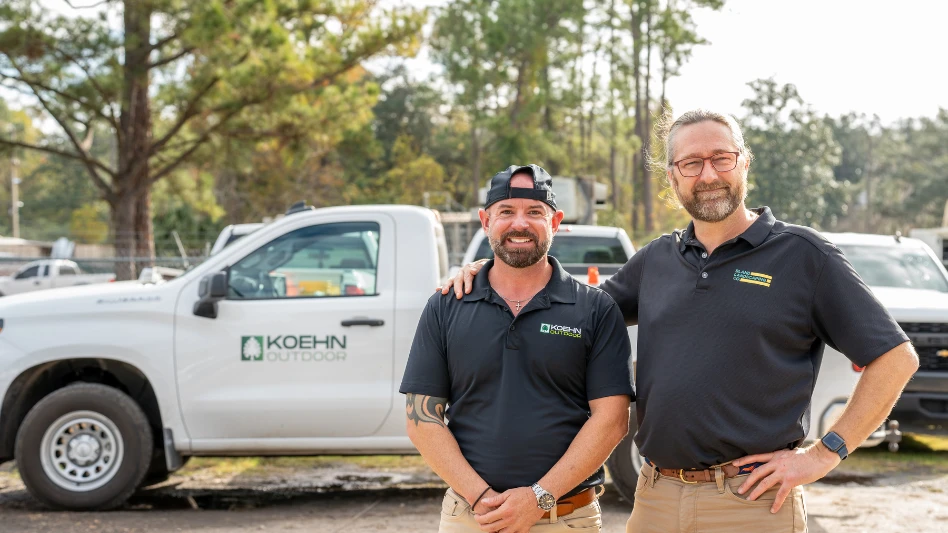 Composite pavers, made from recycled materials, are a robust, green option for landscape contractors. Photos: VAST Minnesota residents have more to worry about after 20 inches of snow has fallen than cracked driveways and patios.
Composite pavers, made from recycled materials, are a robust, green option for landscape contractors. Photos: VAST Minnesota residents have more to worry about after 20 inches of snow has fallen than cracked driveways and patios.
That’s why Joe Lemmerman and two others formed EarthPavers in St. Bonifaicus to exclusively install VAST Composite Pavers, a product that comes with a lifetime guarantee for no cracking or absorption of water.
“That’s something we need in Minnesota,” Lemmerman says.
Composite pavers use recycled rubber and plastic materials instead of concrete or clay. They’re stabilized with sand instead of grout. No standing water or cracking will be found if the job is done right.
Composite products weigh less than concrete and can be cut with wood saws, reducing labor and time for installation, something the owners of EarthPavers enjoy.
“We can do the install with just the few of us,” Lemmerman says. He believes they work 30 to 40 percent faster than those who install typical concrete pavers.
VAST Composite Pavers are 95 percent recycled – 70 percent rubber and 25 percent plastic. The company claims every 5,000-square foot landscape application keeps 2,500 automobile tires and 75,000 gallon-sized plastic containers out of U.S. landfills. Composite pavers also provide credits toward LEED – Leadership in Energy and Environmental Design – projects.
“We’re saving stuff in landfills,” Lemmerman says. “It’s just a superior product. They’re great looking, and they hold up beautifully.”
Going Green
Paul Ramacher of Greenway Pavers in Minneapolis also enjoys VAST’s environmentally-friendly qualities.
“It’s green, and people just love it,” Ramacher says. “As more and more people find out about it, we keep getting busier and busier, and we can work with it exclusively.”
Greenway Pavers formed three years ago, and first started with concrete pavers.
“Once we saw the VAST pavers and tried them, there was just no going back,” Ramacher says. “They are so nice to work with, so easy to use and they don’t need any specialty tools.”
The Minneapolis-based group now installs only VAST pavers and has no plans of branching out. Ramacher says more architects are noticing the new composite pavers and commercial projects are catching on.
Greenway Pavers’ two full-time employees and handful of seasonal workers see their annual revenue on the rise, says Ramacher, something he credits to the recycled pavers.
Enhanced Look
Sometimes companies don’t have a choice on which type of paver to use, especially when working on commercial projects, as is the case with LPS Pavement Co., based in Oswego, Ill.
Pat Taylor, adminstrator at LPS, says the company has installed both concrete and permeable pavers on streets, plazas and university walkways across the U.S.
The advantage of pavers compared to large slabs of concrete is the more sophisticated look, Taylor says. “There’s more design appeal and better color,” she says.
Better Construction
Claddagh Paving works with universities, hospitals, residential neighborhoods – anywhere that wants concrete, permeable, brick or natural stone pavers.
The compay pulled in $2 million in revenue last year, and has 20 employees, who take advantage of the speed of paver installations on big jobs.
“All of Europe was paved in cobblestone hundreds of years ago and it still stands now,” says Cody Biggerstaff, an estimator with Claddagh in Fallbrook, Calif. “The easiest thing (with pavers) is it’s segmental. They don’t crack, they don’t break.”
“You have a lot less maintenance,” Biggerstaff says of pavers. “Almost all concrete will eventually crack, and pavers last forever.”
Claddagh has seen an increase in the use of composite pavers.
“People love them, especially in California – it’s a big green state,” Biggerstaff says. “I see it being a huge thing in the next three to five years.”
The author is an intern at Lawn & Landscape magazine. She can be reached at kpickerel@gie.net.

Explore the December 2009 Issue
Check out more from this issue and find your next story to read.
Latest from Lawn & Landscape
- Analysis of an entrepreneur
- Terra Nova's Sedum Conga Line variety wins Best of 2024 Perennial award
- Different ways to distribute
- Case's 580EV electric backhoe loader wins Good Design Award
- Davey Tree promotes Dan Herms to VP, GM of Davey Institute
- Caterpillar's Cheryl H. Johnson set for April retirement
- Registration open for sixth annual Lawn & Landscape Technology Conference
- 12 interview questions to help you hire winners





